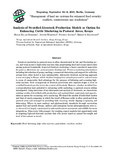Analysis of Stratified-Livestock Production Models as Option for Enhancing Cattle Marketing in Pastoral Areas, Keny

View/
Date
2015Author
Dabasso, BH
Wasonga, O
Irungu, P
Kaufmann, B
Kaufmann, Brigitte
Language
enMetadata
Show full item recordAbstract
Livestock marketing in pastoral areas is often characterised by low and fluctuating prices, and weak access to high-value markets, thus perpetuating food and income insecurities
among pastoral households. Improved livestock marketing is hence considered imperative
for poverty alleviation and socio-economic development. Previous marketing interventions
including introduction of group ranching, commercial destocking and support for collective
actions have either failed or lack sustainability. Alternative livestock marketing approach
is now emerging in Kenya, which involves bringing lean animals produced in pastoral areas
to areas of comparative feed advantage for the purpose of fattening and accessing high-
value markets. Such arrangement of livestock production into separate stages is term as
stratified livestock-production in the context of this study. However, whether stratified live-
stock-production have potential to enhancing cattle marketing in pastoral areas is seldom
investigated. Using interviews of key informants and analysis of literatures, we characterise
existing models of stratified-cattle production and analysed their constraints and opportunities as option for enhancing cattle marketing. We found the models of individual traders
and that of ranch-companies in which the breed of Borana cattle is often purchased from
pastoral areas and managed by providing daily watering, weekly dipping or spraying and
deworming. Efforts to meet sanitary and phytosanitarty standards through vaccination
against foot and mouth disease, anthrax and contagious bovine pleuropneumonia were also observed but largely constrained by informal livestock movements and wildlife-livestock
integrations. This create little prospect for reaching export markets but opportunity exist
in targeting high-end domestic markets that offer prices based on animal live-weight and
level of fat-content achieved
URI
http://www.tropentag.de/2015/abstracts/links/Dabasso_ijTfwL6f.pdfhttp://hdl.handle.net/11295/91623
Citation
Tropentag, September 16-18, 2015, Berlin, Germany “Management of land use systems for enhanced food security: conflicts, controversies and resolutionsPublisher
University of Nairobi
